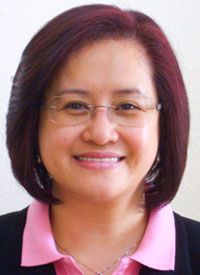Royce Discusses the Importance of Patient Selection in HER2+ Breast Cancer
Melanie E. Royce, MD, PhD, discusses the recent progress in the landscape of HER2-positive breast cancer and what she envisions future treatment approaches will be for patients.
Melanie E. Royce, MD, PhD

Melanie E. Royce, MD, PhD
Novel combinations, particularly regimens that do not include chemotherapy, are being explored for patients with HER2-positive breast cancer.
In the ongoing, open-label phase II PERTAIN trial, for example, adding an aromatase inhibitor (AI) to pertuzumab (Perjeta) and trastuzumab (Herceptin) was found to improve progression-free survival (PFS) by 3.09 months when compared with trastuzumab plus an AI.
The trial enrolled 258 postmenopausal women with HER2-positive, HR-positive locally advanced or metastatic breast cancer. Patients were randomized to receive pertuzumab with trastuzumab (n = 129) or trastuzumab (n = 129) alone in combination with an AI with or without induction chemotherapy.
The results, which were presented during the 2016 San Antonio Breast Cancer Symposium, also showed that the median PFS was 18.89 months with the pertuzumab combination compared with 15.80 months for trastuzumab and an AI alone (HR, 0.65; 95% CI, 0.48-0.89;P= .007).
These findings relate to a recent point made by Melanie E. Royce, MD, PhD, on the importance of optimal patient selection to determine which patients with HER2-positive breast cancer can avoid toxic chemotherapy regimens.
“In fact, if we are able to select the proper patients, we can give them selective therapies with very few toxicities,” said Royce. “We are improving their lives, in terms of quantity and quality.”
In an interview withTargeted Oncology, Royce, a professor of Medicine at the University of New Mexico Comprehensive Cancer Center, discussed the recent progress in the landscape of HER2-positive breast cancer and what she envisions future treatment approaches will be for patients.
TARGETED ONCOLOGY:What have been some exciting advancements in HER2-positive breast cancer?
Royce:
The most important thing is that the natural history of HER2-positive breast cancer has improved over the last decade. It really is the fact that we are now combining HR-positive treatment and HER2-targeted therapy together without chemotherapy. That is a very exciting thing. We are trying to de-escalate our therapy for patients, and it is possible, in select patients, to dial down their therapy. For many patients, that is what they want to do. Because their outcomes are so good, we can dial back their therapy.
The main issue is, in which patients can we dial down the therapy? That is the really exciting part of the futureto be able to identify those patients that will do well, and do well with less toxic therapy.
TARGETED ONCOLOGY:What steps are we already taking to answer these questions?
Royce:
The most exciting part in the future is really selecting these patients. There are a lot of tests out there that we are developing. What we don’t yet know is what the best test is to select these patients. For the future, that is the research question that we really need to ask.
Once we’ve determined the best way to identify these patientsand it may turn out that there’s more than 1 way to do it—that’s good. Then, the most important thing is to select these patients properly and deliver the right care to them.
TARGETED ONCOLOGY:What are the biggest challenges associated with the available HER2-targeted therapies?
Royce:
The major thing is that there are still patients who relapse, despite the fact that we have made such huge improvements. For these patients, we still need new drugs and new ways to continue to improve their outcomes, because we are not curing everyone. Our goal is to give the very best outcomes to everyone.
TARGETED ONCOLOGY:What ongoing trials are exploring novel regimens in HER2-positive patients?
Royce:
They are not practice changing yet, but [will be] in the future. We are looking at newer agents; some of them are in phase III trials, but we don’t have the full results yet. For instance, we are looking at PI3K inhibitors.
One of the other things, too, is immunotherapy. Immunotherapy is something that is already in practice in other diseases. In breast cancer, it has not really panned out yet. Perhaps the way to investigate it in breast cancer is of a slightly different manner than how we are investigating it in other cancers, such as lung cancer or melanoma. This is possibly because the mutational load in breast cancer is not as heavy as those 2 diseases. Still, this is an exciting area.
TARGETED ONCOLOGY:What are some other novel agents being explored?
Royce:
Aside from the immunotherapy [PD-1] inhibitors, the other agents are the oral pan-HER inhibitors, for instance, that are better than the ones we have currently.
For instance, the oral tyrosine kinase inhibitors that we have today, such as lapatinib (Tykerb), are sort of in the further-line therapy setting. However, there are newer therapies that may turn out to be far better than lapatinib that may actually have better penetration in the brainwhich is a sanctuary site for many of our HER2-positive patients that fail in that area. That is an area that we actually need to address.
TARGETED ONCOLOGY:What about the small-molecule inhibitor ONT-380?
Royce:
We have seen exciting activity with ONT-380, both as a single agent and in combination. That is being studied now in combination with estrogen receptor¬ (ER)targeted therapy, and in a triplet regimen with the CDK 4/6 inhibitors. There is the triplet of that plus HER2-targeted therapy. There are a lot of studies ongoing. Unfortunately, we don’t have the results of these studies, but they are up and coming and exciting.
TARGETED ONCOLOGY:What are the most important points for community oncologists to take away from your presentation?
Royce: